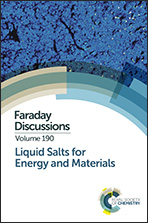Application of infiltrated LSCM–GDC oxide anode in direct carbon/coal fuel cells
Abstract
Hybrid direct carbon/coal fuel cells (HDCFCs) utilise an anode based upon a molten carbonate salt with an oxide conducting solid electrolyte for direct carbon/coal conversion. They can be fuelled by a wide range of carbon sources, and offer higher potential chemical to electrical energy conversion efficiency and have the potential to decrease CO2 emissions compared to coal-fired power plants. In this study, the application of (La, Sr)(Cr, Mn)O3 (LSCM) and (Gd, Ce)O2 (GDC) oxide anodes was explored in a HDCFC system running with two different carbon fuels, an organic xerogel and a raw bituminous coal. The electrochemical performance of the HDCFC based on a 1–2 mm thick 8 mol% yttria stabilised zirconia (YSZ) electrolyte and the GDC–LSCM anode fabricated by wet impregnation procedures was characterized and discussed. The infiltrated oxide anode showed a significantly higher performance than the conventional Ni–YSZ anode, without suffering from impurity formation under HDCFC operation conditions. Total polarisation resistance (Rp) reached 0.8–0.9 Ω cm2 from DCFC with an oxide anode on xerogel and bituminous coal at 750 °C, with open circuit voltage (OCV) values in the range 1.1–1.2 V on both carbon forms. These indicated the potential application of LSCM–GDC oxide anode in HDCFCs. The chemical compatibility of LSCM/GDC with carbon/carbonate investigation revealed the emergence of an A2BO4 type oxide in place of an ABO3 perovskite structure in the LSCM in a reducing environment, due to Li attack as a result of intimate contact between the LSCM and Li2CO3, with GDC being stable under identical conditions. Such reaction between LSCM and Li2CO3 was not observed on a LSCM–YSZ pellet treated with Li–K carbonate in 5% H2/Ar at 700 °C, nor on a GDC–LSCM anode after HDCFC operation. The HDCFC durability tests of GDC–LSCM oxide on a xerogel and on raw bituminous coal were performed under potentiostatic operation at 0.7 V at 750 °C. The degradation mechanisms were addressed, especially on raw coal.
- This article is part of the themed collection: Liquid Salts for Energy and Materials

 Please wait while we load your content...
Please wait while we load your content...